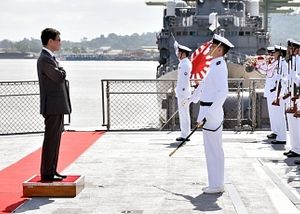This week, Japan’s defense ministry announced that it would be holding an activity focused on humanitarian assistance and disaster relief inviting all Southeast Asian states and the ASEAN Secretariat. The engagement is just the latest in a series of interactions Tokyo is rolling out as part of its wider regionwide engagement with Southeast Asian countries as part of its broader Indo-Pacific vision.
As I have noted before in these pages, though Japan has long been a key contributor to capacity-building for Southeast Asian states in areas ranging from maritime security to humanitarian assistance and disaster relief (HADR), these efforts have been stepped up under Prime Minister Shinzo Abe. This includes not just boosting ties with individual states like the Philippines, Vietnam, and Malaysia, but also strengthening ties with ASEAN as a whole, a trend that has continued as part of Japan’s own Indo-Pacific vision (See: “ASEAN’s Role in Japan’s Indo-Pacific Strategy”).
This trend has been due both to the converging interests between the two sides, including concerns about China’s rising assertiveness in the East China Sea and South China Sea, as well as changes in Japan’s defense policy back home, with the overturning of a ban on arms exports in April 2014 paving the way for defense equipment and technology cooperation and transfers. As a result, it is no surprise that we have seen some notable movement on ASEAN-Japan ties over the years, such as the convening of the inaugural ASEAN-Japan Defense Ministers’ Informal Meeting back in December 2014, which added to the Japan-ASEAN Defense Vice-Ministerial Forum.
An example in this respect was Tokyo’s unveiling of the Vientiane Vision back in November 2016, which was billed as the first initiative that conceived of Japan’s defense collaboration with ASEAN as a whole rather than just ongoing cooperation with select Southeast Asian states (See: “Japan Reveals First ASEAN Defense Initiative with Vientiane Vision”). Since then, slowly but surely, we have witnessed a few initiatives in line with this as well in 2017, be it increased resources targeted at boosting coast guard capacity-building as well as wider maritime law enforcement training in collaboration with other external partners like the United States (See: “Trump’s Indo-Pacific Strategy Challenge”).
On February 26, in another move of this ilk, Japan’s defense ministry announced that it would conduct a Japan-ASEAN invitation program on humanitarian assistance and disaster relief that would last from February 26 until March 2. According to the ministry, the initiative, billed as part of the Vientiane Vision, would be the first of its kind that invites military and civilian representatives from all ASEAN member states as well as the ASEAN Secretariat.
The program’s purpose was framed as being part of Tokyo’s ongoing attempts to boost the capabilities of ASEAN member states as well as to foster personal ties and improve awareness about Japan’s own disaster response system and capabilities among regional states. It includes seminars on HADR as well as site visits at select JSDF facilities.
Few additional specifics were publicly provided about the engagement ahead of its launch. But it was yet another indication that Japan continues to see expanding security ties with Southeast Asian states and ASEAN as a whole as being an important part of its overall regional strategy, both on its own terms as well as in its engagement with other extraregional partners.

































